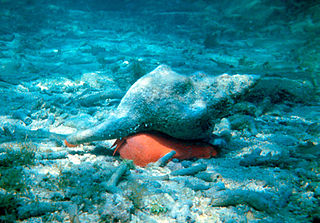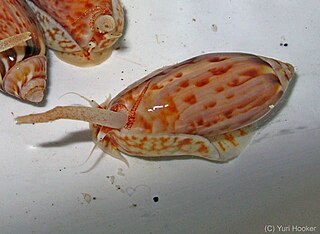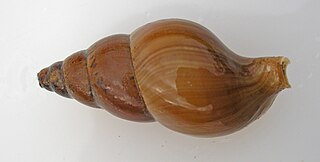
Triplofusus giganteus, commonly known as the Florida horse conch, or the giant horse conch, is a species of extremely large predatory subtropical and tropical sea snail, a marine gastropod mollusc in the family Fasciolariidae, the spindle snails, tulip snails and their allies. On average, it weighs over 11 pounds.

Busycotypus canaliculatus, commonly known as the channeled whelk, is a very large predatory sea snail, a marine prosobranch gastropod, a busycon whelk, belonging to the family Busyconidae.

Olive snails, also known as olive shells and olives, scientific name Olividae, are a taxonomic family of medium to large predatory sea snails with smooth, shiny, elongated oval-shaped shells.

The Buccinidae are a very large and diverse taxonomic family of large sea snails, often known as whelks or true whelks.

Buccinum is a genus of medium-sized sea snails, marine gastropod molluscs in the family Buccinidae, the true whelks.

Buccinum undatum, the common whelk or the waved buccinum, is a large, edible marine gastropod in the family Buccinidae, the "true whelks".

The siphonal canal is an anatomical feature of the shells of certain groups of sea snails within the clade Neogastropoda. Some sea marine gastropods have a soft tubular anterior extension of the mantle called a siphon through which water is drawn into the mantle cavity and over the gill and which serves as a chemoreceptor to locate food. Siphonal canals allow for active transport of water to sensory organs inside the shell. Organisms without siphonal canals in their shells rely on passive or diffuse transport or water into their shell. Those with siphonal canals have a direct inhalant stream of water that interacts with sensory organs to detect concentration and direction of a stimulus, such as food or mates. In certain groups of carnivorous snails, where the siphon is particularly long, the structure of the shell has been modified in order to house and protect the soft structure of the siphon. Thus the siphonal canal is a semi-tubular extension of the aperture of the shell through which the siphon is extended when the animal is active.

Olivellinae, are a subfamily of small predatory sea snails with smooth, shiny, elongated oval-shaped shells, in the family Olividae. The shells sometimes show muted but attractive colors, and may have some patterning.
Buccinum thermophilum is a species of sea snail, a marine gastropod mollusk in the family Buccinidae, the true whelks.

Aesopus clausiliformis is a species of sea snail, a marine gastropod mollusk in the family Columbellidae, the dove snails.
Fusinus aepynotus, known as the graceful spindle, is a species of small sea snail native to the Gulf of Mexico and southern Florida.

Nucella lamellosa, commonly known as the frilled dogwinkle or wrinkled purple whelk, is a species of sea snail, a marine gastropod mollusk in the family Muricidae, the murex snails or rock snails. This species occurs in the eastern Pacific Ocean, its range extending in the intertidal zone from the Aleutian Islands southward to central California.

Buccinum baerii, common name Baer's buccinum, is a species of sea snail, a marine gastropod mollusk in the family Buccinidae, the true whelks. The epithet is written by some authors as "baeri".

Buccinum strigillatum is a species of sea snail, a marine gastropod mollusk in the family Buccinidae, the true whelks.

Nassarius fossatus, the channeled basket snail, is a species of sea snail, a marine gastropod mollusc in the family Nassariidae, the nassa mud snails or dog whelks. It is native to the west coast of North America where it is found on mudflats on the foreshore and on sand and mud in shallow water.

Mancinella armigera is a species of sea snail, a marine gastropod, in the family Muricidae, the murex snails or rock snails. The species name means “bearing arms”.

Lottia instabilis is a species of sea snail, a true limpet, a marine gastropod mollusk in the family Lottiidae. Common names include the unstable limpet, the unstable seaweed limpet and the rocking chair limpet. It is native to the northern Pacific Ocean where it feeds on kelp in the intertidal zone and the shallow sub-littoral zone.

Lirabuccinum is a genus of sea snails, marine gastropod mollusks in the family Tudiclidae, the true whelks.

Neptunea smirnia, the chocolate whelk, is a species of sea snail, a marine gastropod mollusk in the family Buccinidae, the true whelks. It was first described to science by William Healey Dall in 1919. The type specimen was collected from the Strait of Juan de Fuca in 114 fathoms of water.

Latisipho morditus is a species of sea snail, a marine gastropod mollusk in the family Buccinidae, the true whelks.
















